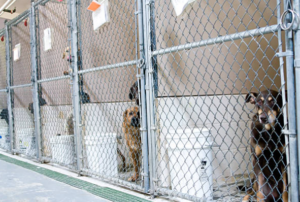Addressing the Importance of Shelter Adoption

In a world where trends come and go, and beauty standards evolve, there’s a timeless elegance in the act of compassion — the choice to adopt a pet from a shelter instead of shopping for one. While the allure of purebred animals may be tempting, the beauty of adopting a shelter pet transcends aesthetic preferences. In this blog, we will explore the profound impact of adopting, not shopping, emphasizing the importance of shelter adoption for both the pets and their human companions.
The allure of purchasing a purebred pet often stems from the desire for a specific appearance, lineage, or documented pedigree. However, beneath the surface of this seemingly glamorous choice lies a harsh reality that extends beyond the individual preferences of potential pet owners.
When individuals choose to purchase pets from breeders or pet stores, they may unknowingly support the cruel and exploitative practices of puppy mills. These facilities prioritize profit over the welfare of animals, subjecting them to deplorable conditions. The animals in these mills often endure overcrowded living spaces, lack of proper veterinary care, and minimal socialization, leading to physical and psychological health issues.
Pets from commercial breeders may be at a higher risk of genetic disorders and health issues. The pursuit of specific physical traits in purebred animals can lead to overbreeding, resulting in a higher likelihood of congenital diseases and hereditary conditions. While reputable breeders prioritize the health and well-being of their animals, the lack of regulations in the breeding industry means that many animals face health challenges due to irresponsible breeding practices.
The choice to shop for pets perpetuates the cycle of overpopulation, leading to an increasing number of animals in need of homes. As long as there is demand for commercially bred animals, there will be a surplus of animals in shelters and rescues. This overpopulation often results in the heartbreaking reality of abandoned or euthanized pets, creating a continuous cycle of suffering.
The Unique Charm of Shelter Pets
While breed-specific traits often capture attention, the beauty of shelter pets lies in their individuality, resilience, and the captivating stories each one carries. Choosing a shelter pet transcends the confines of breed standards, offering a unique and heartwarming experience.
Shelter pets often come in a delightful assortment of mixed breeds, creating a unique tapestry of physical characteristics and personalities. Embracing the mystery of a mixed-breed pet adds an element of surprise and discovery to the adoption process. Each patchwork of fur and every distinctive feature becomes a testament to the pet’s diverse heritage, making them truly one-of-a-kind companions.
Shelter pets frequently enter rescue facilities with diverse backgrounds, ranging from abandonment and neglect to the loss of a loving home. Despite their past hardships, these animals showcase an unparalleled resilience and capacity for love. The beauty of a shelter pet lies not only in their physical appearance but also in their ability to overcome adversity and form new, trusting relationships.
When you adopt a shelter pet, you’re not just gaining a companion; you’re opening your heart to unconditional love and gratitude. Many shelter animals have faced hardship and uncertainty, and when they find a loving home, their gratitude shines through in every wag of a tail or gentle purr. The bond formed through adoption is a testament to the resilience of animals and the transformative power of love.
Many shelter pets have experienced trauma or loss, making their capacity for healing and providing emotional support particularly poignant. Adopters often find that the presence of a shelter pet brings a sense of calm and companionship, acting as a source of emotional support during challenging times. The unconditional love offered by these pets becomes a powerful force in promoting mental well-being and resilience.
The moment a shelter pet steps into their new home is an emotionally charged experience. The gratitude and joy expressed by the pet during this homecoming are indescribable. Whether it’s the wagging tail of a dog or the content purring of a cat, the beauty of the welcome resonates as a tangible expression of gratitude for the newfound love and security.
The beauty of adopting a shelter pet is not just in receiving love but in forming a two-way street of understanding. Shelter pets, often perceptive to human emotions, contribute to a unique dynamic where both parties intuitively respond to each other’s needs. This mutual understanding enhances the bond, creating a relationship characterized by empathy, companionship, and shared moments of joy.
The act of adopting a shelter pet goes beyond individual happiness; it’s a collective effort to save lives. Shelters are often overcrowded, and by choosing adoption, you directly contribute to reducing the population of homeless animals. Each adopted pet creates space for another in need, fostering a cycle of compassion that ripples through communities.

The Beauty of Second Chances
Shelter adoption is a celebration of second chances. Many shelter pets have faced adversity, whether through abandonment, abuse, or neglect. By opening your home to a shelter pet, you become a beacon of hope, offering them a chance at a new and brighter chapter in their lives. Witnessing the transformation of a once-mistreated animal into a beloved family member is a beautiful testament to the power of compassion.
The beauty of adopting a shelter pet extends to the process itself. Visiting a shelter, meeting different animals, and forming connections create a rich and rewarding experience. The adoption process is an opportunity to align with a pet whose personality and energy resonate with yours. It’s a journey of mutual discovery, and the moment you find your perfect match is a truly beautiful one.
Addressing Myths and Misconceptions
To fully appreciate the beauty of shelter adoption, it’s essential to dispel common myths and misconceptions. From concerns about behavioral issues to misconceptions about the availability of specific breeds, understanding the reality of shelter pets helps break down barriers that may prevent potential adopters from considering this life-changing choice.
Myth: Shelter Pets Have Behavioral Issues
One prevalent misconception is that all shelter pets come with behavioral issues. In reality, the majority of animals in shelters are loving, well-adjusted pets that, through no fault of their own, find themselves in need of a new home. Many shelters conduct behavioral assessments to match pets with suitable adopters, ensuring a harmonious transition into their new families.

Myth: Shelters Only Have Mixed-Breed Pets
Contrary to the belief that shelters exclusively house mixed-breed pets, many shelters have a diverse array of both purebred and mixed-breed animals. Breed-specific rescue organizations also exist, focusing on the care and rehoming of specific breeds. Shelters offer a broad selection of pets, providing potential adopters with various options to match their preferences and lifestyle.
Myth: Older Pets are Less Adaptable
Some individuals may mistakenly assume that older shelter pets are less adaptable or trainable than their younger counterparts. In truth, many older pets are already house-trained and may require less intensive training. Additionally, older pets often adapt well to new environments and form deep bonds with their adopters, bringing a sense of calm and companionship to the home.
Myth: You Can’t Find Purebred Pets in Shelters
The belief that purebred pets are rare in shelters is a common misconception. Due to various reasons, including changes in owners’ circumstances or a lack of breed-specific rescues, purebred animals can end up in shelters. Adopters seeking a particular breed are encouraged to check both shelters and breed-specific rescue organizations to find their ideal companion.
Myth: Shelter Pets are Only There Because of Behavioral Problems
It’s crucial to debunk the misconception that all shelter pets are there due to behavioral problems. Pets end up in shelters for various reasons, such as changes in their owners’ lives, economic hardships, or unforeseen circumstances. The majority of shelter animals are well-behaved, loving companions who deserve a second chance at a forever home.
Myth: You Can’t Bond with a Shelter Pet Like You Can with a Puppy or Kitten
Another myth suggests that bonding with a shelter pet, especially an older one, is challenging compared to bonding with a puppy or kitten. In reality, shelter pets of all ages can form deep and meaningful bonds with their adopters. The gratitude and loyalty expressed by shelter pets create a unique and fulfilling connection that transcends age.
Myth: All Shelter Pets Have Health Issues
Concerns about the health of shelter pets often deter potential adopters. While some shelter pets may have pre-existing health conditions, many are in good health, and shelters typically conduct veterinary assessments before adoption. Adopters receive information about the pet’s health history, allowing for transparent decision-making regarding their care.
Myth: Shelter Pets Can’t Be Trusted Around Children
Safety concerns about shelter pets around children are unfounded in most cases. Shelters prioritize the safety and well-being of both pets and potential adopters, conducting temperament assessments to ensure compatibility. Many shelter pets are well-suited for family life, demonstrating gentleness and adaptability in various environments.

The Economic and Environmental Impact
Shelter adoption not only transforms individual lives but also contributes to broader societal and environmental well-being. Adopting a shelter pet is often more cost-effective than purchasing from a breeder, as many shelters cover initial vaccinations, spaying/neutering, and sometimes even microchipping. Additionally, choosing adoption reduces the demand for commercial breeding, indirectly promoting a more sustainable and compassionate approach to pet companionship.
To foster lasting change, it’s essential to raise awareness about the benefits of shelter adoption. Advocacy for spaying and neutering, supporting local shelters, and dispelling myths can collectively shift societal perceptions. The beauty of shelter adoption lies not only in personal choices but in contributing to a cultural shift towards a more humane and compassionate approach to pet ownership.
In a world filled with choices, adopting a shelter pet emerges as a profoundly beautiful and compassionate act. It goes beyond aesthetics and breed preferences, transcending into the realm of saving lives, fostering gratitude, and building meaningful connections. As we celebrate the beauty of adopting, not shopping, let us remember that true beauty lies in the transformative power of love and compassion — a power that resonates in the wag of a tail, the purr of contentment, and the unspoken bond between a shelter pet and their human companion. Adopt, don’t shop, and embark on a journey of beauty, compassion, and shared joy.

